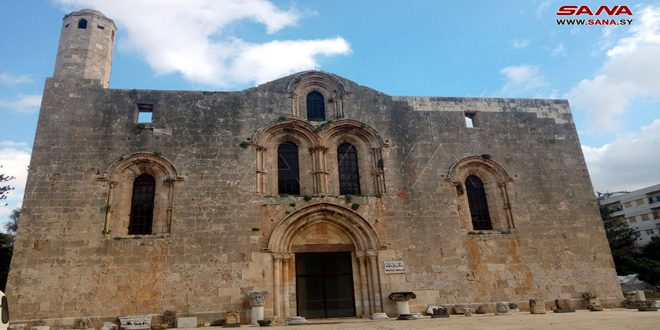Tartous, (ST) – The ancient and archaeological cities have their own identity due to the cultural and social diversity they carry as a result of the succession of civilizations.
 The old city of Tartous is one of the most important archaeological cities with a distinctive architectural style and one of the historical inhabited cities registered on the list of national heritage in Syria.
The old city of Tartous is one of the most important archaeological cities with a distinctive architectural style and one of the historical inhabited cities registered on the list of national heritage in Syria.
The community of the Old City is emotionally connected to the sea, and this is evident from the enthusiasm of its people to work in the sea. It is characterized by simplicity, kindness, cooperation, cohesion, and social solidarity.
The old city retains most of its architectural features and geometric shapes that are consistent with the foundations of urban planning-with a distinctive defensive system.
 It consists of layers of protection, including the Episcopal city, where the cathedral is considered one of the most important and beautiful architectural buildings and still maintains its medieval architectural style, in addition to its durability despite the accidents it experienced and the impact of harsh weather factors, as it is located near the coast.
It consists of layers of protection, including the Episcopal city, where the cathedral is considered one of the most important and beautiful architectural buildings and still maintains its medieval architectural style, in addition to its durability despite the accidents it experienced and the impact of harsh weather factors, as it is located near the coast.
The old city is concentrated in the center of Tartous and overlooks the Mediterranean Sea. It is distinguished by its proximity to Arwad Island and the port. It takes the form of a semicircle facing towards the sea and is distributed into two main sectors: The first is the citadel, which includes (the waterfront, the moat, and the square), and the second is the transitional segment (the plain and part of the ruins). It also has four main entrances called the Municipality Mosque, the Marine Corniche, the Peace Mosque, and the Sahla.
In an interview with SANA, the director of the old city, Mervat Othman, said: The old city includes the Cathedral of Our Lady of Tartous, which is the first church dedicated to the name of the Virgin Mary in the East. Great attention was paid to it during the time of the Byzantines and it was rebuilt during the era of the Crusaders. It is distinguished by its Frankish architectural character and dates back to the thirteenth century, but its importance declined after the Franks left Tartous and it was turned into a mosque in 1851 AD, and then the Ministry of Culture turned it into a museum in 1914 AD.
 Among the archaeological landmarks in the old city Mervat Othman added is The Knights Templar Citadel, located in the northwestern part of the Episcopal City, which formed the basis of the residential neighborhood that began to take shape in the Mamluk era until the present day.”
Among the archaeological landmarks in the old city Mervat Othman added is The Knights Templar Citadel, located in the northwestern part of the Episcopal City, which formed the basis of the residential neighborhood that began to take shape in the Mamluk era until the present day.”
She explained that the castle was built in 1183 and is composed of a double wall surrounded by water moats dug into the rock, and its main entrance is called the Gate Tower. In the 13th century AD, all the buildings that characterize any eastern castle of that period were built within the walls.
Othman pointed out that the urban development of the current city of Tartous in general and the absence of early protection measures for all the basic components of the archaeological city led to the destruction of a large part of this city and the emergence of new buildings that reached the borders of the old city.
Returning to the history of the Old City, we can say that it is one of the most important examples of the continuity of life in Syrian historical cities, which reflect the civilizational and cultural diversity that it experienced through the various historical eras from Phoenician, Greek, Roman, Byzantine, Arab, Islamic, Crusader, and Mamluk until our present era.
 According to historical sources, the Old city of Tartous has been considered a seaport since the Phoenician era 2000 BC, and it was considered one of the important commercial settlements of the Phoenician Kingdom of Arwad.
According to historical sources, the Old city of Tartous has been considered a seaport since the Phoenician era 2000 BC, and it was considered one of the important commercial settlements of the Phoenician Kingdom of Arwad.
Currently, the Old city of Tartous is considered one of the most important archaeological cities registered on the National Heritage List in Syria, as it was registered on the list of archaeological cities pursuant to Ministry of Culture Resolution No. 139 of 1999.
It is noteworthy that the Old city is located northwest of the city of Tartous, above a flat rock table extending over a distance of 300 meters. This table ends on the western side directly at the beach, and overlooks the sea opposite Arwad Island, at a distance of 2 and half kilometers to the southwest, into the sea.
Raghda Sawas


 Home
Home